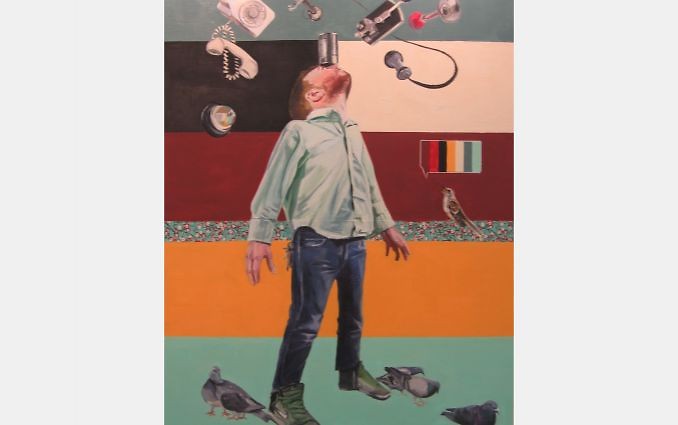Displayed at the Collins Gallery on the campus of Grand Rapids Community College, Jessica can Type and Steven can Honk, Dustin Roger's 2013 ArtPrize entry, represents the sometimes inadequate communication between a man and a woman. The two-panel oil painting depicts “the challenge of sending a message and of being misunderstood," Rogers explains, "especially with today’s electronic technology, which people use to escape reality.” Central to his work is a decidedly low-tech tin can telephone, a device that Rogers, an MFA candidate at Kendall, and his friends began to experiment with. Experimenting with tin-can communication provided some of the initial concepts for the painting.
A fellow Kendall student and a local librarian modeled for the piece, photographed in various poses with and expressing various attitudes toward the tin can. The panel featuring the female includes textual images such as wood letterpress letters and a mechanical pencil, while the male subject balances the tin can phone on his nose. This second panel includes auditory images: a horn and a telephone. “The panels represent life: school, work, family, searching; it’s about balance,” Rogers says. Both panels share similarly arranged fabric swaths, a visual device that creates continuity between the two figures – the desire to communicate successfully. Images of birds and a dog convey how animals may be more attuned to human emotions than we are.
Rogers admits that miscommunication in his own marriage, typical of all relationships, influences much of what the piece represents. “My wife is a wordsmith," he says with a smile. "She likes to edit me."
Praising ArtPrize for offering new artists a place to start since anyone can exhibit, Rogers offers this advice to fellow newcomers: “Just submit it (your work). Don’t be afraid of the technology.” The competition allows Rogers, for a short time, to focus his work in a personal direction, away from the peer review process of graduate school. “Though I did choose an academic life,” says the future art teacher, “it’s nice to be able to paint for me.”
Acknowledging the economic stimulus ArtPrize provides to Grand Rapids, the soft-spoken newcomer (he and his family moved from Virginia when he was accepted into the MFA program at Kendall) believes the event is great for the community because of the engagement it provides. “It gets people to talk about art — people need things to talk about at dinner.” What makes good art? In Rogers opinion, good art is “whatever a person responds to." He adds the importance of understanding what draws us in, however. "If you do respond to something, stay for a few minutes and ask yourself why.”
When Rogers and his family arrived in Grand Rapids from northern Virginia (near Washington D.C.), he was struck not only by the lack of traffic, but by the friendliness of the people he encountered. “Strangers would strike up conversations at the store.” The thirty-one year old George Mason University graduate was also surprised by the amount of young people in graduate school. “I found it odd to be above the median age.”
Married for six years, Rogers worked his way through college as a paint salesman, a job he credits with developing his love for color and density. After college, he took a year off, working in a frame shop. Wanting to further his education, a scholarship opportunity at Kendall lured him to Michigan, where he has enjoyed mountain biking the trails of West Michigan.
Revisiting personally significant past projects, Rogers has watched his art progress from drawing to painting. “My direction as an artist changes,” he says, “I start something and go on to something else.” He names painters such as Rackstraw Downes, Paula Rego, and Jerome Witkin as favorite artists who have influenced his work. “I react to seeing process in work.”
Inspired by landscapes and color, Rogers credits an uncle and his maternal grandfather, a Rhode Island farmer, for his interest in wide landscapes and decaying agricultural structures. “Objects and symbols are relevant to me,” he reports. About his grandfather, who died when he was seven years old, he reflects on the possibility of a subtle, generational form of communication. “I wonder if this is what his influence would have been on me should he have lived longer.”
The Collins Gallery is located on the 4th floor of the Main building of Grand Rapids Community College, 143 Bostwick N.E.
The Rapidian, a program of the 501(c)3 nonprofit Community Media Center, relies on the community’s support to help cover the cost of training reporters and publishing content.
We need your help.
If each of our readers and content creators who values this community platform help support its creation and maintenance, The Rapidian can continue to educate and facilitate a conversation around issues for years to come.
Please support The Rapidian and make a contribution today.
